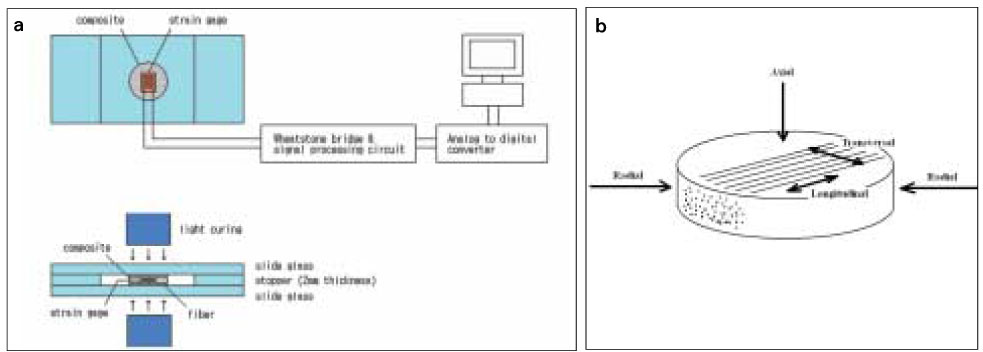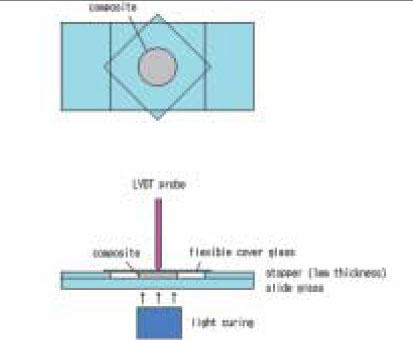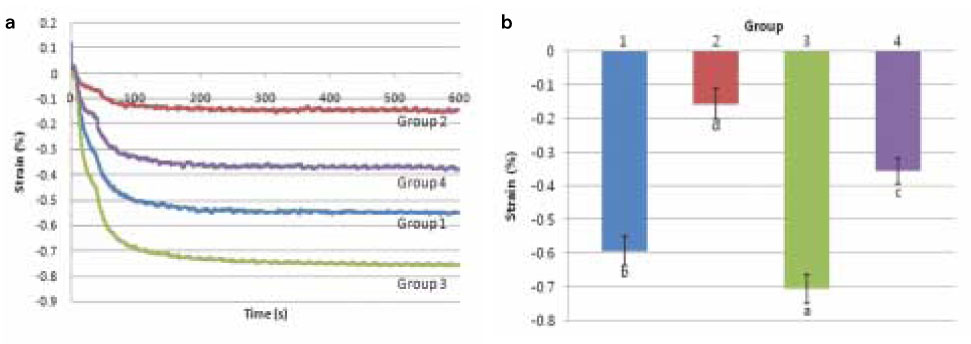J Korean Acad Conserv Dent.
2009 Jul;34(4):364-370. 10.5395/JKACD.2009.34.4.364.
Effect of fiber direction on the polymerization shrinkage of fiber-reinforced composites
- Affiliations
-
- 1Department of Conservative Dentistry, School of Dentistry, Seoul National University, Korea. inboglee@snu.ac.kr
- KMID: 2176170
- DOI: http://doi.org/10.5395/JKACD.2009.34.4.364
Abstract
- The aim of this study was to evaluate the effect of fiber direction on the polymerization shrinkage of fiber-reinforced composite. The disc-shaped flowable composite specimens (d = 10 mm, h = 2 mm, Aeliteflo A2, Bisco, Inc., IL, USA) with or without glass fiber bundle (X-80821P Glass Fiber, Bisco, Inc., IL, USA) inside were prepared, and the longitudinal and transversal polymerization shrinkage of the specimens on radial plane were measured with strain gages (Linear S-series 350omega, CAS, Seoul, Korea). In order to measure the free polymerization shrinkage of the flowable composite itself, the disc-shaped specimens (d = 7 mm, h = 1 mm) without fiber were prepared, and the axial shrinkage was measured with an LVDT (linear variable differential transformer) displacement sensor. The cross-section of the polymerized specimens was observed with a scanning electron microscope to examine the arrangement of the fiber bundle in composite. The mean polymerization shrinkage value of each specimen group was analyzed with ANOVA and Scheffe post-hoc test (alpha=0.05). The radial polymerization shrinkage of fiber-reinforced composite was decreased in the longitudinal direction of fiber, but increased in the transversal direction of fiber (p<0.05). We can conclude that the polymerization shrinkage of fiber-reinforced composite splint or restoratives is dependent on the direction of fiber.
Keyword
MeSH Terms
Figure
Reference
-
1. Giachetti L, Scaminaci Russo D, Bambi C, Grandini R. A review of polymerization shrinkage stress: current techniques for posterior direct resin restorations. J Contemp Dent Pract. 2006. 7:79–88.
Article2. Vallittu PK, Lassila VP, Lappalainen R. Acrylic resin-fiber composite-Part I: The effect of fiber concentration on fracture resistance. J Prosthet Dent. 1994. 71:607–612.
Article3. Vallittu PK. Acrylic resin-fiber composite--Part II: The effect of polymerization shrinkage of polymethyl methacrylate applied to fiber roving on transverse strength. J Prosthet Dent. 1994. 71:613–617.
Article4. Goldberg AJ, Burstone CJ. The use of continuous fiber reinforcement in dentistry. Dent Mater. 1992. 8:197–202.
Article5. Butterworth C, Ellakwa AE, Shortall A. Fibre-reinforced composites in restorative dentistry. Dent Update. 2003. 30:300–306.
Article6. Dyer SR, Lassila LV, Jokinen M, Vallittu PK. Effect of cross-sectional design on the modulus of elasticity and toughness of fiber-reinforced composite materials. J Prosthet Dent. 2005. 94:219–226.
Article7. Tezvergil A, Lassila LV, Vallittu PK. The effect of fiber orientation on the polymerization shrinkage strain of fiber-reinforced composites. Dent Mater. 2006. 22:610–616.
Article8. Sakaguchi RL, Versluis A, Douglas WH. Analysis of strain gage method for measurement of post-gel shrinkage in resin composites. Dent Mater. 1997. 13:233–239.
Article9. Versluis A, Tantbirojn D, Douglas WH. Distribution of transient properties during polymerization of a light-initiated restorative composite. Dent Mater. 2004. 20:543–553.
Article10. Lassila LV, Vallittu PK. The effect of fiber position and polymerization condition on the flexural properties of fiber-reinforced composite. J Contemp Dent Pract. 2004. 5:14–26.
Article11. Lee IB, Cho BH, Son HH, Um CM, Lim BS. The effect of consistency, specimen geometry and adhesion on the axial polymerization shrinkage measurement of light cured composites. Dent Mater. 2006. 22:1071–1079.
Article12. Sakaguchi RL, Wiltbank BD, Shah NC. Critical configuration analysis of four methods for measuring polymerization shrinkage strain of composites. Dent Mater. 2004. 20:388–396.
Article
- Full Text Links
- Actions
-
Cited
- CITED
-
- Close
- Share
- Similar articles
-
- Polymerization shrinkage kinetics of silorane-based composites
- A new method to measure the linear polymerization shrinkage of composites using a particle tracking method with computer vision
- Evaluation of polymerization shrinkage stress in silorane-based composites
- The effect of viscosity, specimen geometry and adhesion on the linear polymerization shrinkage measurement of light cured composites
- Degree of Conversion and Polymerization Shrinkage of Low and High Viscosity Bulk-Fill Giomer-based and Resin-based composites






